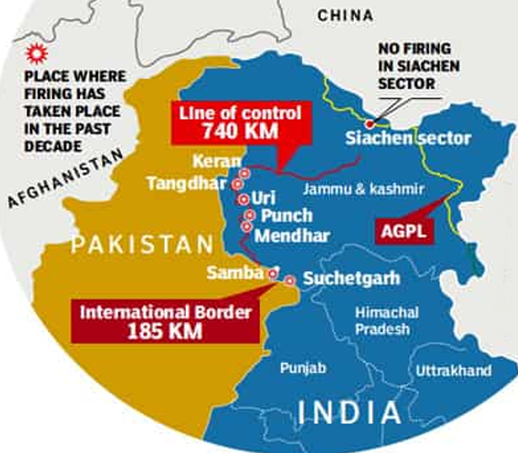Why in News?
Pakistani troops violated the ceasefire along several sectors at the Line of Control (LoC) and International Border for the 8th consecutive night following the April 22 Pahalgam terrorist attack, which killed 26 civilians.
The Indian army has retaliated to each of these violations in a calibrated and proportionate manner.
Though no casualties yet, the situation marks the most intense ceasefire breakdown since the 2021 Directorates General of Military Operations (DGMOs) ceasefire agreement.
What’s in Today’s Article?
- Evolution of the India-Pakistan Ceasefire
- Nature of Ceasefire Violations
- Ceasefire Understanding of 2021 and Its Significance
- Current Developments and Strategic Outlook
- Conclusion
Evolution of the India-Pakistan Ceasefire:

- Origin and legal ambiguity:
- Ceasefire Line first established via Karachi Agreement (1949) post 1948-49 war.
- Simla Agreement (1972) renamed it as the LoC, not an international boundary (IB) but a military control line.
- Ceasefire agreement between the two nations is not a formal treaty; but based on military-level "understandings".
- LoC and IB - Distinct legal interpretations:
- LoC (de facto border between India and Pakistan): 740 km, from Sangam in Kashmir to Point NJ-9842 near the Siachen Glacier.
- IB:
- In Jammu, the LoC changes into the IB for India, since it has no territorial claims on Pakistani Punjab on the other side.
- But for Pakistan, the IB is a “Working Boundary”, since it claims Jammu on the Indian side - and hence deems the border unsettled.
- Operational dynamics:
- Heavy troop presence with fortified structures on both sides.
- Seasonal terrain shifts affect actual positions.
- Mandate is to prevent infiltration and unilateral changes.
- However, there has been a rise in infiltration and Pakistan Border Action Teams (BAT) raids since 1989.
- Ceasefire often violated and restored informally - e.g., 2003, 2021.
Nature of Ceasefire Violations:
- Motivations behind violations:
- Typically increase during every bilateral crisis since 1972 to impose military costs on the other side.
- Such violations have ranged from limited small-arms fire to full-fledged cross-border operations such as the Indian surgical strikes against terrorist infrastructure in Pakistan occupied Kashmir in 2016.
- "Autonomous military factors": Local commanders act independently for boosting troop morale, revenge, testing enemy resolve.
- Absence of formal rules of engagement:
- No strict protocols prevent firing; governed by unwritten SOPs.
- Conflict resolution mechanisms:
- Flag meetings between local commanders.
- Hotlines between DGMOs in New Delhi and Rawalpindi.
- These reduce escalation but do not prevent future violations.
Ceasefire Understanding of 2021 and Its Significance:
- Strategic rationale behind 2021 understanding:
- Pakistan: Internal instability and Afghanistan border tensions.
- India: Focus on China and the Line of Actual Control (LAC, Ladakh).
- Result: Drop in violations, increased civilian safety, agriculture revival, and economic stability in border villages.
- Diplomatic and military communication:
- Since the 2019 India-Pakistan diplomatic freeze, only military-level communication remains active.
- Weekly DGMO calls continue; April 29 call saw India objecting to ongoing violations.
Current Developments and Strategic Outlook:
- Cross-border dynamics post-Pahalgam attack:
- Firing possibly used by Pakistan to maintain military pressure and leverage.
- India needs to:
- Retaliate (militarily) to the Pakistani violations.
- Resolve BSF jawan detention issue (crossed IB accidentally on April 23).
- During times of crisis, such accidental crossings act as leverage for one side over the other.
- Risks of escalation:
- Ceasefire violations are low-intensity yet high-risk events.
- Often the first and most controlled military response in crisis.
- However, risk of rapid escalation remains, especially under public or political pressure.
Conclusion:
Ceasefire at the LoC remains an evolving military understanding, prone to crises and local dynamics.
Despite communication mechanisms, long-term peace requires political will and strategic foresight.









